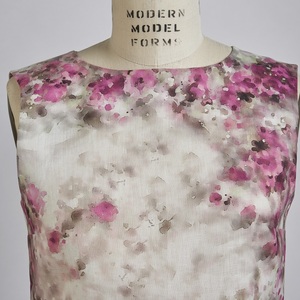
I used silk organza for both facings and interfacings. It provides a light, crisp finish and adds just enough structure.
One of my favorite ways to finish the edges of neckline and front opening facings on an unlined garment–especially when I’m using a lightweight and/or sheer fabric and have sewn the garment together with French seams–is to face them with the interfacing. It works beautifully, even when the interfacing is fusible. Just follow these basic steps:
1. Choose the type of interfacing that’s right for your fabric. I’ve shown two garment examples. One is a very sheer silk white blouse that I’ve underlined with China silk to make it a little less “see through.” I’ve used solid silk organza for the front and back neck facings and the same organza to interface these areas. The tissue-weight green silk blouse is not so sheer and I’ve interfaced the facings with a lightweight fusible knit interfacing.
2. Cut the facings and interfacings according to your pattern.
3. Sew back neck facing to front facings and back neck interfacing to front interfacing.
4. Sew the interfacing unit to the facing unit at the outer edges with a ¼-inch seam, keeping right sides together. If you’re using fusible interfacing, be sure that the fusing side is on the outside.

Sew interfacing to edge of facing, right sides together.
5. Grade the seam in favor of the interfacing (leave the interfacing seam allowance slightly wider than the facing seam allowance).
6. Carefully press the seam open. This is a little tricky when you’re using a fusible. Be careful just to press along the stitching line with the very tip of the iron and don’t let the iron plate touch the interfacing.

Press seam open carefully — especially when using fusible interfacing.
7. Turn and press the interfacing and facing together (now you can use the whole iron), first along the seamed edge so it’s nice and flat.

Turn interfacing to the inside and fuse in place.
8. Attach the facing to the garment and tack in place at the seams where necessary.

The facing edge is cleanly finished. 
When using a patterned sheer fabric, use plain organza for facings and interfacings.







































Great idea for a professional finish.
Wish I'd thought of that before! To save your iron from getting sticky when pressing seam open, try using a sheet of silicone baking parchment between your fusible interfacing and your iron.
I have never used silk organza. Is it machine washable? Great article!
i have come to love silk organza very much i have just done a course with susan Kahjale.
I cannot wait to use more and more of it i am also loving the inside of my garment as much as the out side.
thank you for the above
I've been doing this for years. I was visiting a friend and saw a blouse his sister had made like this and just loved it so I've been doing it ever since. I haven't seen it done by anyone else since so I'm glad you posted it here!
I have used this technique for finishing facings for years. It also works extremely well for unlined jackets--helps the facing to stay in place and to keep its shape, all of which helps the garment to drape better.
This is how I learned to face facings at Texas Women's Uni. when I attended in the 60's. I still use that method even though serging is a bit much faster.
I just love this! It is revolutionary.....this technique came at a great time for me because I am making a silk button down the front dress right now, and this worked just beautifully! Thank you......
Great idea! I definately plan on using this in the near future for a professional look to the garment. They make silk organza in different colors. Could try to match the garment and organza in a close color match. I've tried to dye silk to match items and that can be interesting. Haven't tried the interfacing yet but who knows?
Great idea! I definately plan on using this in the near future for a professional look to the garment. They make silk organza in different colors. Could try to match the garment and organza in a close color match. I've tried to dye silk to match items and that can be interesting. Haven't tried the interfacing yet but who knows?
Lovely idea to use the organza for the facing and the interfacing. I love the method for finishing the unattached edges first and teach it in my beginning sewing classes.
These look really neat & very effective.
Just as an aside - any ideas/suggestions as to where I can get hold of a really good professional dressmaker's stand -we always used STOCKTON's when I was at college, which we were taught to 'pad up'to our individual sizes. The only ones which seem to be available here are always those polyester covered expandable things which are unacceptable.
Beautiful the finish, i'm agree that when you make things inside neat it's much better but too it's showes often a better outside as well.
thank you for sharing this solution and the great tute you've made;-D
This is right on time. I just cut out a blouse from a stripe fabric and was saying to myself that I should cut the facing out of a solid fabric because the main fabric is lightweight and somewhat sheer. Thank God for His grace in my life. I printed this article and will use it to complete my project. Once it is completed, I will upload a pic for all to see. Thank you Mary Ray for being instrumental in helping me to complete my project with the utmost perfection!
Great idea. I have always thought the turned over edge on facings was a dead giveaway that the garment was 'homemade'.
I will definitely be using this from now on.
Thanks. This is a great tip.
Thanks for the tips on increasing the length of the facing that is one tip I will use a lot.
I appreciate your work